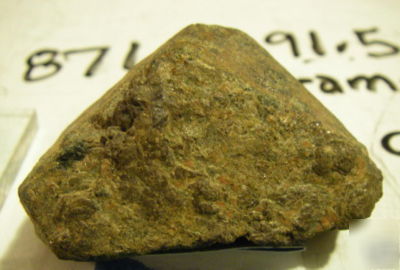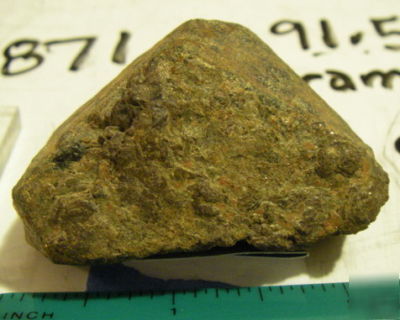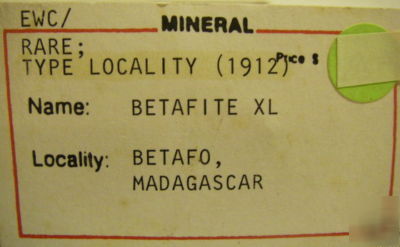Machine Recycling Discussion and Moderated Newsgroup > Full Machines
> Complete Machines
> Welders
> East
> Used
> Betafite - big xl, betafo madagas type locality 90K cpm
Betafite - big xl, betafo madagas type locality 90K cpm
INTERNATIONAL OK - but any package will be UN2910 marked.
these pictures are of the same lot you will receive.
international to be most likely $43.45
Comes mounted in a baseball sized lexan box - with tags and lables - looks professionally mounted.
Rare (I have not seen many Betafites cystals this big !)
REF: Lauf in Introduction to Radioactive Materials - page 39
Crystals up to 7 cm .... have been reported (Heinrich 1958)
Geiger Sensitive - 90,000 CPM Mylar Side of Ludlum 44-9 pancake 10,000 back side
9,500 CPM CDV 700 probe opened 1,800 tube closed Some Gammas here !
These are certain everyday items which have been specifically approved for distribution and may be possessed by members of the general public without a license. These include watches, clocks and other timekeeping of navigational devices, unrefined ores, and smoke detectors.
Local pickup just west of Washington DC allowed without charge.
Just a bit about Fluorescent Minerals. (additional tie-in words for searchers)
Fluorescent Minerals are a wonderful addition to any mineral collection! Study of Geological Ores and Minerals that Fluoresce can be an insight into the way that electron transitions occur in materials with optical properties. Fluorescent Minerals have their uses in Scientific Study and in producing beautiful Artwork.
The study of geology can be a great adventure. There are many types of mineral and ore samples. Common minerals such as quartz are made up of the elements silicon and oxygen. Rutile is made up of titanium and oxygen. Bauxite is made up of aluminum and oxygen. Elements which we come into contact everyday include: hydrogen, lithium, sodium, potassium, fluorine, chlorine, bromine, and many more. Materials which are important in the energy economy of the world include nuclear materials. Elements in these nuclear materials include: Uranium, Thorium, Plutonium, Radon, Radium, lead, bismuth, polonium, americium, beryllium, boron, iron, nickel, cobalt and many more. The materials which are used in nuclear energy operations are referred to as radioactive. Radioactive substances emit radiation. There are many types of radiation: heat, microwaves, light, x-rays, gamma rays, cosmic rays, beta (electrons), alpha particles (helium nuclei), neutrons, neutrinos, and others. Detection of these emissions can be measured by use of Geiger Muller detectors (Geiger Counters - Alpha, Beta, Gamma), Scintillometer Detectors (NaI w/ Tl - Sodium Iodide crystals doped with Thallium Scintillator crystals - Gamma Only), Boron tri-Fluoride detectors (Neutrons), proportional counters, cloud chambers and other detector equipment and schemes. Radiation Detectors used in research include those manufactured by Technical Associates, Ludlum, Eberline, Bicron and others. To be a trained radiological measurements student / professional / person, you need to know how to use instruments from all of these manufacturers and to compare the various capabilities of the different units available. Some of the principal minerals - ores used in the nuclear power industry include: Pitchblende, Uraninite, Uranophane, Torbernite, Tyuyamunite, Carnotite, Cuprosklodowskite, Autunite, Schoepite, Thorite, Cyrtolite, Euxenite, Samarskite, Vandenbrandeite, Soddyite, Curite, Kasolite, Clarkeite, Boltwoodite, Becquerelite, Studtite and others. University education in physics, chemistry and other disciplines requires the student to have a familiarity of the types of materials and the tools used in the analysis and processing of the aforementioned materials and many more topics.





